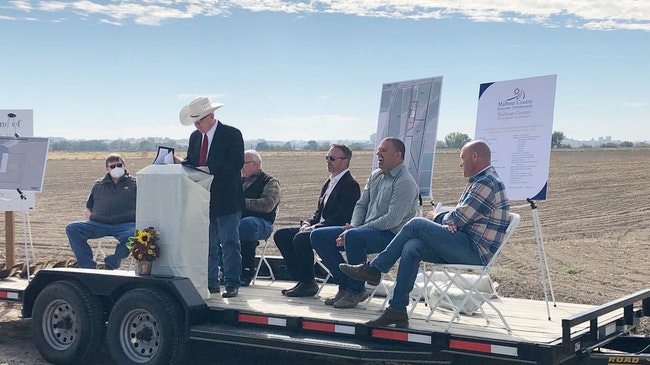
Malheur County Judge Dan Joyce opens the Oct. 1 groundbreaking ceremony for the Treasure Valley Reload Center north of Nyssa. Last week officials opened bids on a second segment of the project. (Malheur County Economic Development Department photo)
ONTARIO – The Treasure Valley Reload Center vaulted over another hurdle last week, receiving bids for a second major segment of construction.
Officials on Thursday, Dec. 16, opened two bids for work to put in rail lines for the Nyssa project, and figures came in higher than engineers had estimated.
Work to build roads and fill in wetlands is underway, months behind schedule. Project managers say the rail center will still be up and running in time for next year’s onion harvest.
Plans call for onion producers to truck their onions to Nyssa for loading onto rail cars and shipment to destinations in the Midwest and East.
The bulk of the reload center is being funded by the state, with $26 million allocated in 2017 and another $3 million in a special state appropriation earlier this year.
To give project managers a way to keep construction on budget, bidders again were directed to split their bids, leaving one of the key rail tracks as an option instead of required.
The lowest main bid came from RailWorks Track Systems Inc., a subsidiary of New York-based RailWorks. The company bid $5,038,144 – about $740,000 over the local estimate. Stacy & Witbeck of Portland bid $6,054,261.
The two companies also bid separately for what’s being called Track C. The first construction bid – for earthwork – also split out the track because of cost concerns.
In last week’s bids, RailWorks priced the extra track work at $1,011,800. Stacy & Witbeck’s bid came in at $1,154,680.
The costs are still within the overall rail budget for the project, according to Brad Baird, president of Anderson Perry & Associates, the firm contracted to do the engineering work on the project.
The most recent amount set aside for the rail, ballast and the third rail spur was about $7 million, said Baird. Earlier this year, Baird privately estimated to project managers the costs would be $10.253 million and then told state transportation officials the costs would be $9.053 million.
“The engineers estimate is based on what you have an idea about. Sometimes you are under and sometimes you are over. The budget has always been tight but we are hanging in there,” said Baird.
The optional rail siding has been in question since last summer. In August, Baird confirmed the $29 million budget for the reload project “will likely not allow” the construction of Track C. The Track C spur is intended to hold rail cars for loading and shipping. Greg Smith, project manager for the reload center and the county economic development director, and his development team said nothing at the time about eliminating the spur.
In September, Baird said the railroad consultants used for the project said it was “really not an option” to drop the spur. Smith confirmed at the time Track C would remain part of the overall rail center blueprint.
The on-again, off-again status of the spur was part of the flexibility of the overall budget built into the project, said Baird.
“You don’t know what the bids are going to be. If the bids come in good, you can keep it (Track C) in the project,” said Baird.
If bids submitted to build that rail track were accepted, the cost for the first two phases of construction would be $1.9 million more than the state was told in January. The budget presented to the state listed a contingency – a reserve against unexpected costs – of $725,000. Baird didn’t respond Monday to an email regarding the status of that rail work or any other changes his firm has made to the project estimates. The status of finances for the project has lingered for nearly a year. In April, for example, the development corporation inked a deal with a local farm family to build a new road impacted by the shipping center. Under the terms of the pact, the county will pay $400,000 to allow Froerer Farms truck access to its agriculture land during harvest and planting seasons on the east side of the Union Pacific Railroad line north of Nyssa.
No project budgets provided by Smith’s team have accounted for that unexpected cost. Baird insisted last week the money was there.
“The $400,000 is in the overall budget,” said Baird.
News tip? Contact reporter Pat Caldwell at [email protected]
Previous coverage:
County trims back rail lines for Nyssa center in cost-cutting move as construction looms.
WATCHDOG: County’s rail team told state key permits were in hand for reload center – they weren’t
EXCELLENCE IN JOURNALISM – Available for $5 a month. Subscribe to the digital service of the Enterprise and get the very best in local journalism. We report with care, attention to accuracy, and an unwavering devotion to fairness. Get the kind of news you’ve been looking for – day in and day out from the Enterprise.




